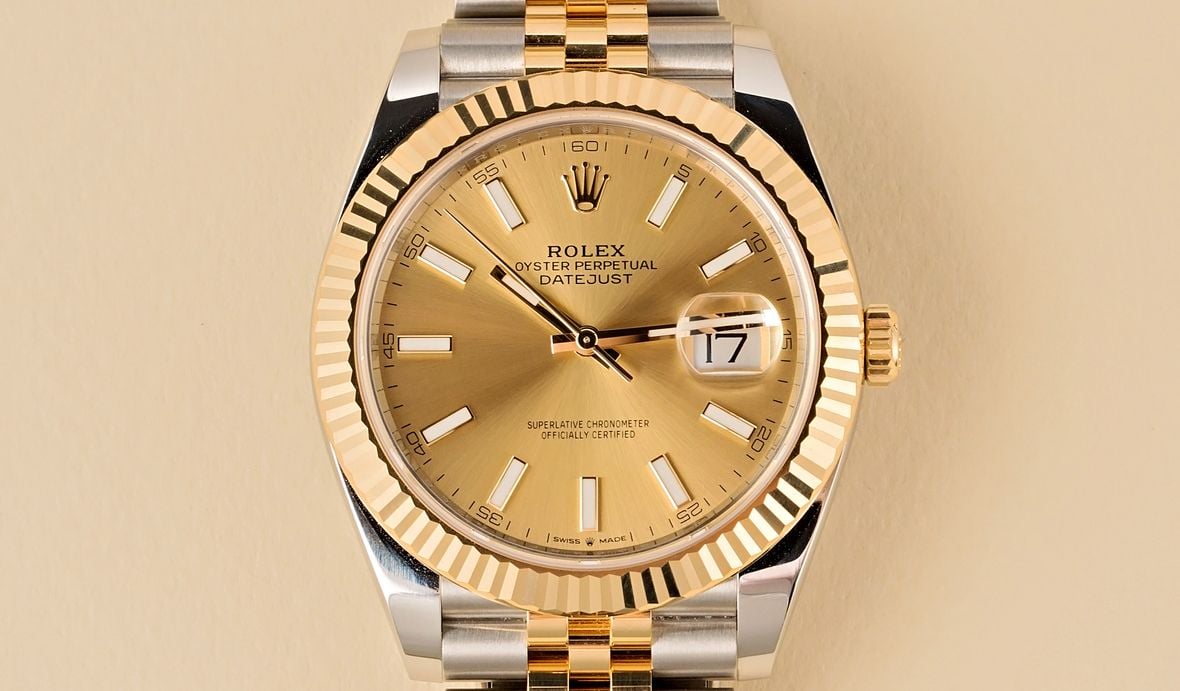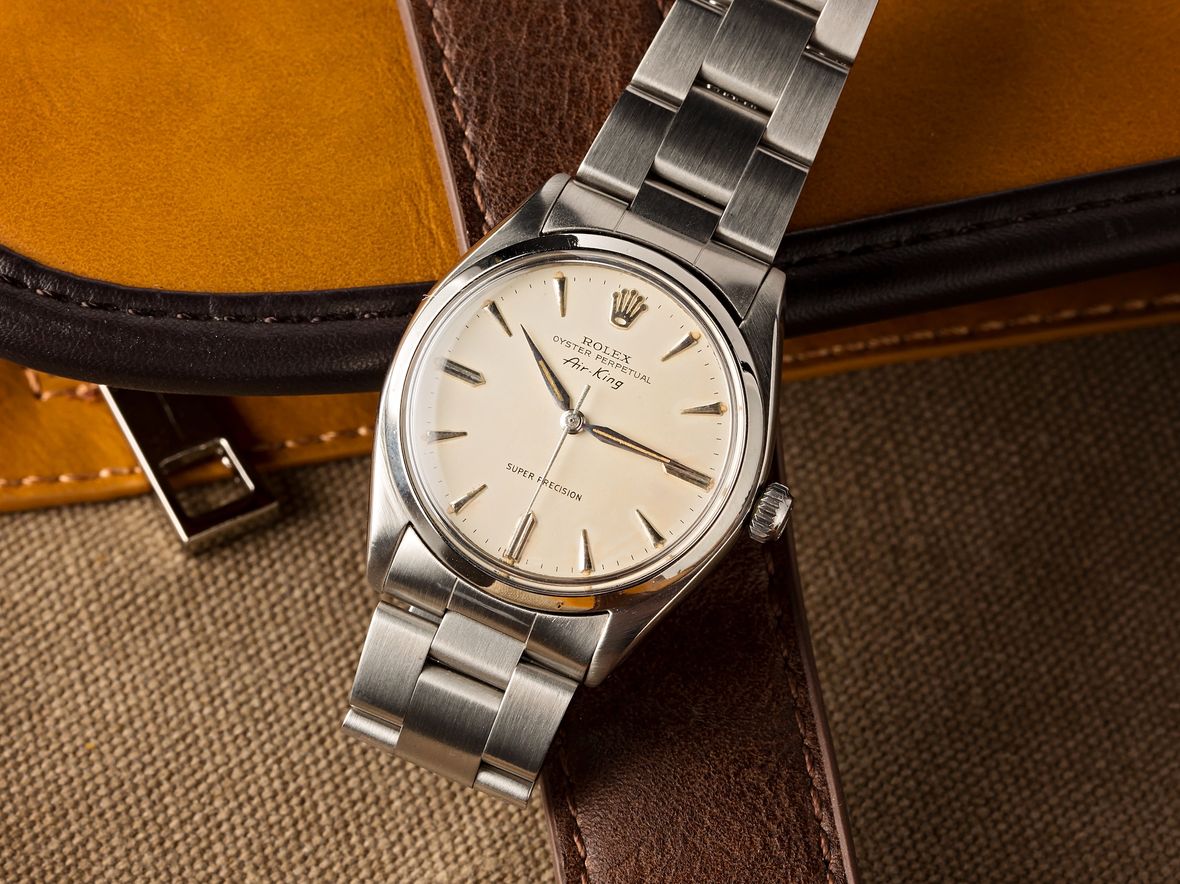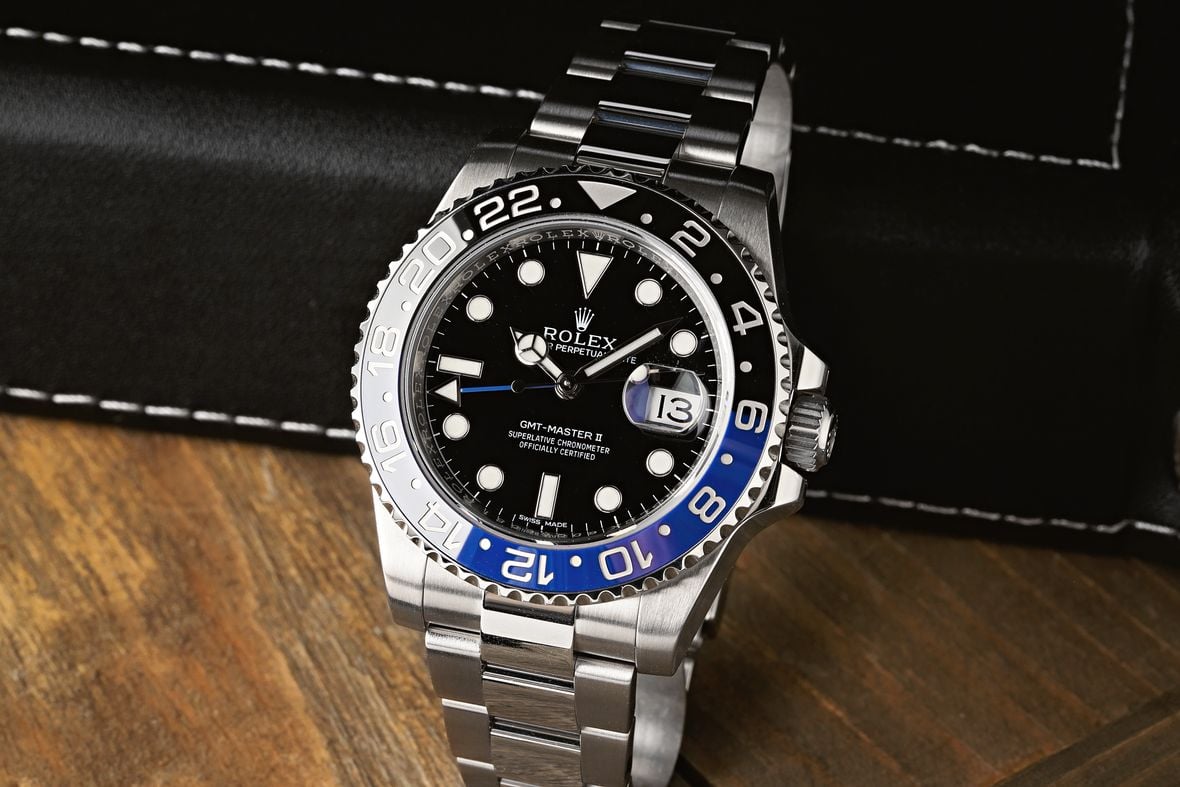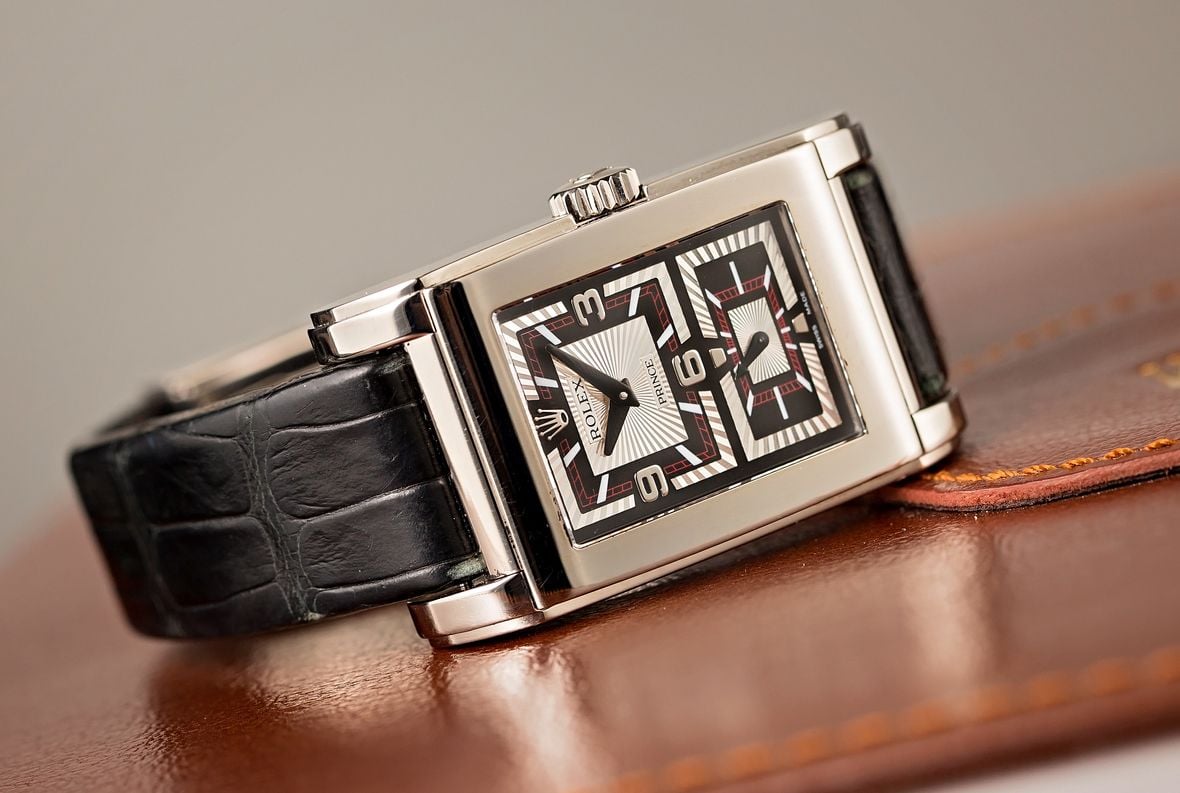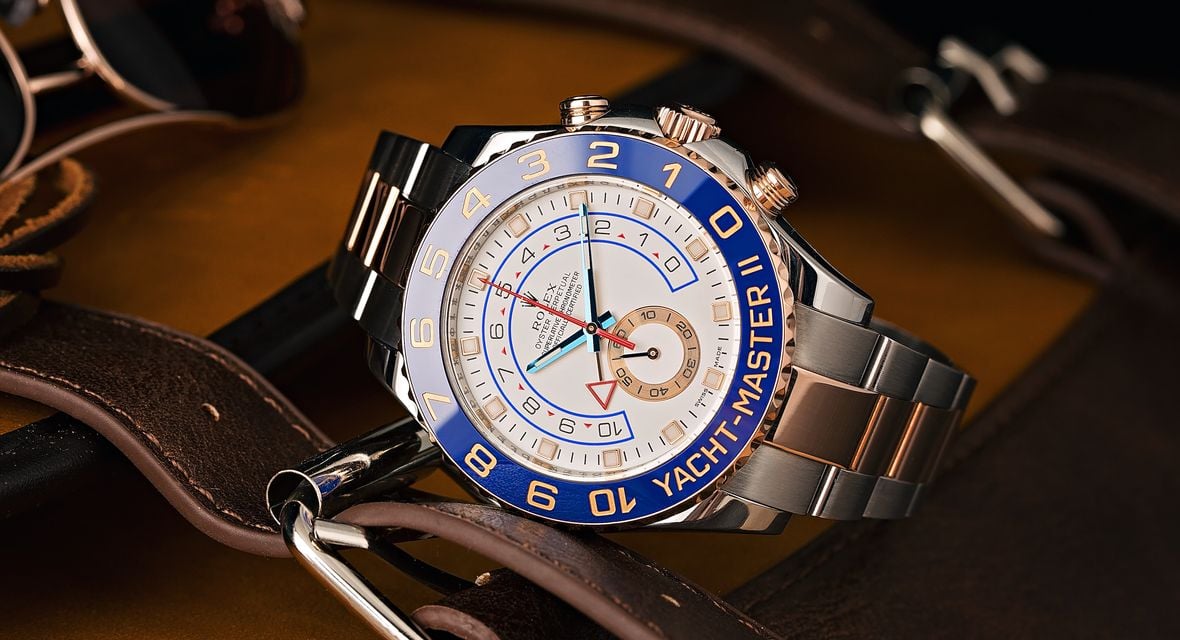‘Perpetual’ is an important word for Rolex. It is the name the brand gave to its self-winding movements, an apt description for something that simply carries on working away endlessly, year after year, at a constant and uninterrupted pace. But it is also a term that perfectly characterizes the brand’s best-selling, most ubiquitous watch: the Rolex Datejust.
While the original Datejust model had its appeal, more modern versions, such as the Rolex 126333, offer upgraded features that align more closely with the collection’s quintessential design – a stainless steel and yellow gold (Yellow Rolesor) watch, complete with the brand’s iconic fluted bezel.
Rolex Datejust 126333
Datejust 126333 Key Features:
- Case Size: 41mm
- Materials: Yellow Rolesor (904L Stainless Steel & 18k Yellow Gold)
- Functions: Time w/Running Seconds, Date Display
- Dial: Champagne, Black, White, Silver, Mother of Pearl, or Slate (Wimbledon)
- Bezel: Fixed, 18k Yellow Gold, Fluted Style
- Crystal: Sapphire (Flat w/Cyclops Lens)
- Water Resistance: 100 Meters / 330 Feet
- Movement: Rolex Caliber 3235
- Strap/Bracelet: Oyster or Jubilee Bracelet
Even though it was unveiled at the same Baselworld event as the ultimate headline-stealer from 2016, the reference 116500LN Daytona, the arrival of the first of the Rolex Datejust 41 series was still big news. With a more refined and universal appeal, the Datejust was able to take aim at a different audience, one which had deemed the 36mm variants a little too small and just a touch too old-school.
It was the same trick that Rolex played with the Day-Date from the year before. That had followed a similar path (and encountered the same public resistance to its proportions) as the Rolex Datejust II, with the short-lived 41mm Day-Date II introduced in 2008, then retired in 2015 to be replaced by the Day-Date 40 with its slightly smaller 40mm case.
The Rolex Datejust Collection

Historically, the key to the Rolex Datejust’s success has been its ability to cater to just about anyone’s taste, through an exhaustive and all-inclusive list of options. For example, there are now five different sizes available, running from the 28mm Lady-Datejust, up through 31mm, 34mm (called simply The Date), the longstanding 36mm model, and 41mm.
On top of that, the Datejust can be found in any of six metal configurations, with three distinct bezel designs, a virtually uncountable number of dials, and three different bracelets (the President bracelet is only fitted to the midsize and Lady-Datejust pieces). As mentioned in our Rolex Datejust 41 review, the many customizable elements make it unlikely you’ll come across someone with the exact same Datejust, making each piece uniquely personal.
The current Datejust 41 range carries on this tradition, although in an unavoidably more limited way. When the Datejust 41 was first launched in 2016, it was only available in two different metal options, both of which were Rolesor (Rolex’s own term for the combination of stainless steel and gold on a single watch), and a stainless steel model did not make an appearance until the following year.
The Rolex Rolesor is a signature look, patented by the brand in 1933 and in constant use across most of the brand’s portfolio since the 1940s. The Datejust, fittingly enough, was the first watch given the treatment. The Datejust 41 arrived in either an Everose Rolesor (with the brand’s proprietary pink gold) or the most recognizable two-tone configuration, Yellow Rolesor. This is the Datejust’s calling card – an instantly familiar visual and one that has virtually become a Rolex emblem.
The Rolex Datejust 41 Reference 126333
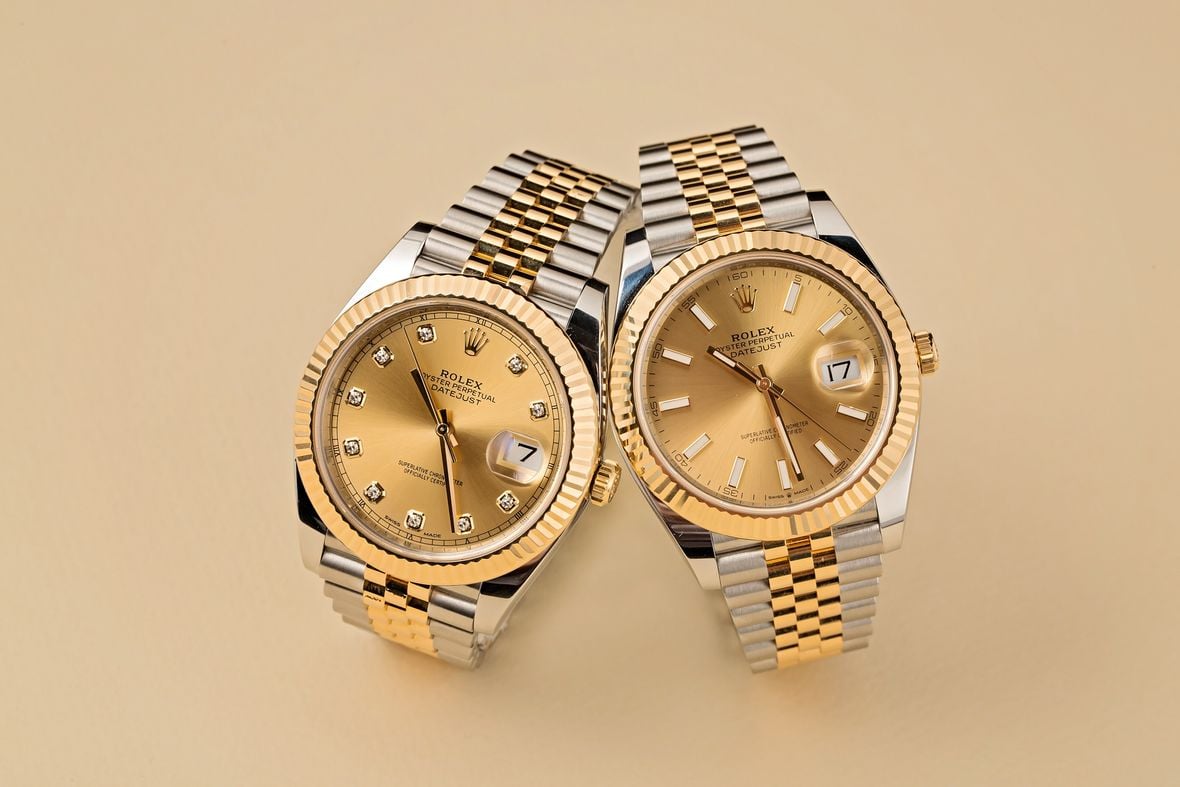
The Yellow Rolesor version, the ref. 126333 was (and still is) an important and interesting model for Rolex and its fans. In fact, you can look at the 41mm Datejust in stainless steel and yellow gold as the perfect metaphor for the brand in the modern era.
The Datejust itself is as established and conventional as they come, but the new size sets it up as acutely contemporary, especially for a dress watch. Additionally, the combination of metals also neatly sums up Rolex’s fundamental philosophy – the steel signifies an underlying focus on strength and resilience, while the gold represents the luxuriousness that has always been a part of everything the brand produces.
The Datejust 41 has grown into one of the most admired new additions to the Rolex portfolio, and the ref. 126333 is held in particularly high regard as the modern continuation of a true industry classic. Below, we take a look at each part of the watch to explore exactly why it all works so well.
Datejust 126333 Case
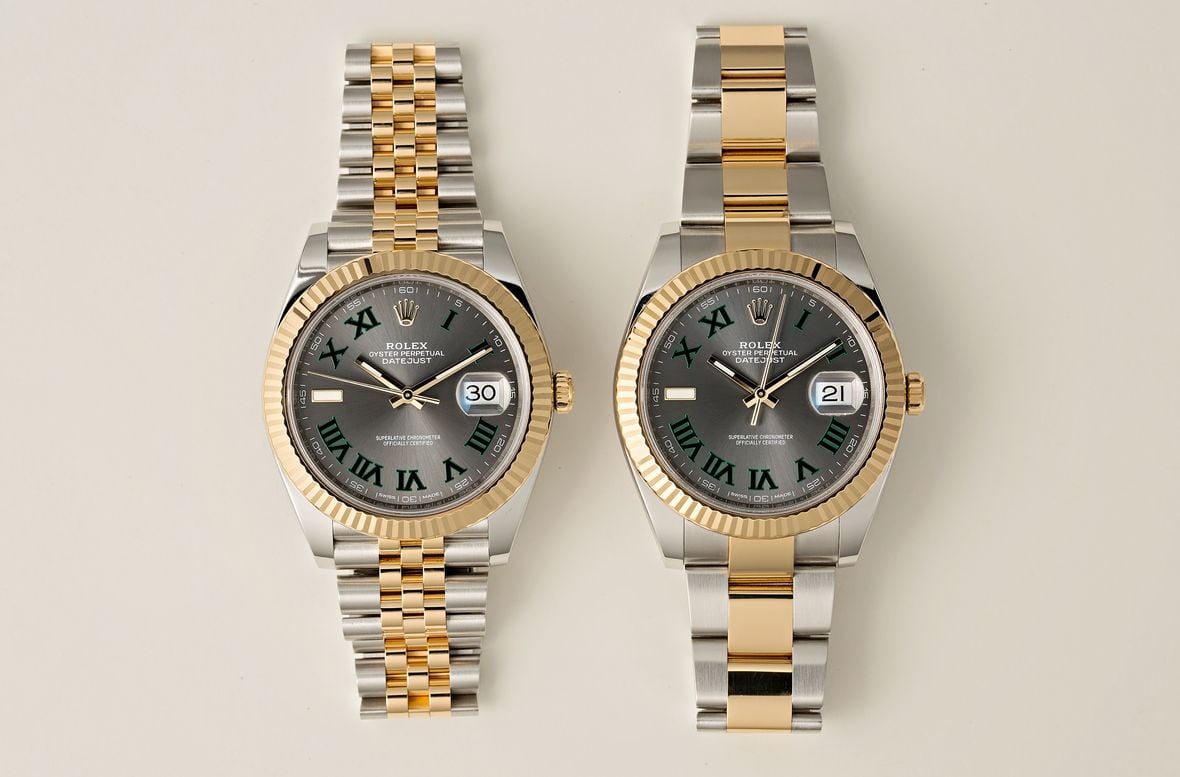
The rather transitory Datejust II, as already stated, lost a lot of the utilitarian elegance of the original. As well as the wider bezel and thicker hour markers, the lugs also gained slightly more girth and the whole watch had a slightly more chunky overall feel.
Not so with the Datejust 41. Although noticeably larger than the 36mm model, there is an overall lightness to the design. A more refined balance has been restored, with the case markedly thinner than the Datejust II and the lugs more slender, tapered at the ends, and curved to better hug the wrist. True to form, the 18k yellow gold crown features Rolex’s Twinlock system, screwing into the Oyster case to ensure 100 meters of water-resistance.
On reference 126333, the 904L stainless steel case is highly polished on top and along the flanks. When Rolex adopted the alloy (which the brand has since rechristened Oystersteel), it was largely due to its heightened resistance to corrosion caused by prolonged exposure to saltwater and chloride, using it first on the Sea-Dweller in 1985.
However, a very welcome side-effect (especially considering the enormous expense Rolex undertook re-tooling their entire production facility to work the metal) was the unique shine 904L holds when polished. That classic Oyster case has a gleam you won’t see on a steel watch from any other manufacturer.
Datejust 126333 Bezels

The definitive finishing touch for a Yellow Rolesor Datejust like the ref. 126333 has long been a fluted bezel. Much like the two-tone aesthetic itself, a fluted bezel is a very long-standing Rolex staple. It actually evolved out of the former coin-edged style the brand used in its formative years, one which had a practical purpose: it gave watchmakers something to grip as they screwed the bezel down onto the case. Over time, that style developed into the series of bold and angular ridges that we are familiar with today, always crafted in solid gold and offering a beautifully subtle yet still eye-catching detail that sets the watch off perfectly.
Being a fairly new addition to the collection, there are no Datejust 41 variants with gem-set bezels (yet), such as the ones that you will find among the other sizes of the watch. While you can get a Datejust 41 with a smooth bezel, the reference 126333 is exclusively offered with a fluted bezel, as indicated by the penultimate digit in its reference number – which in this case is a “3” to denote the presence of a fluted bezel.
Datejust 126333 Dials
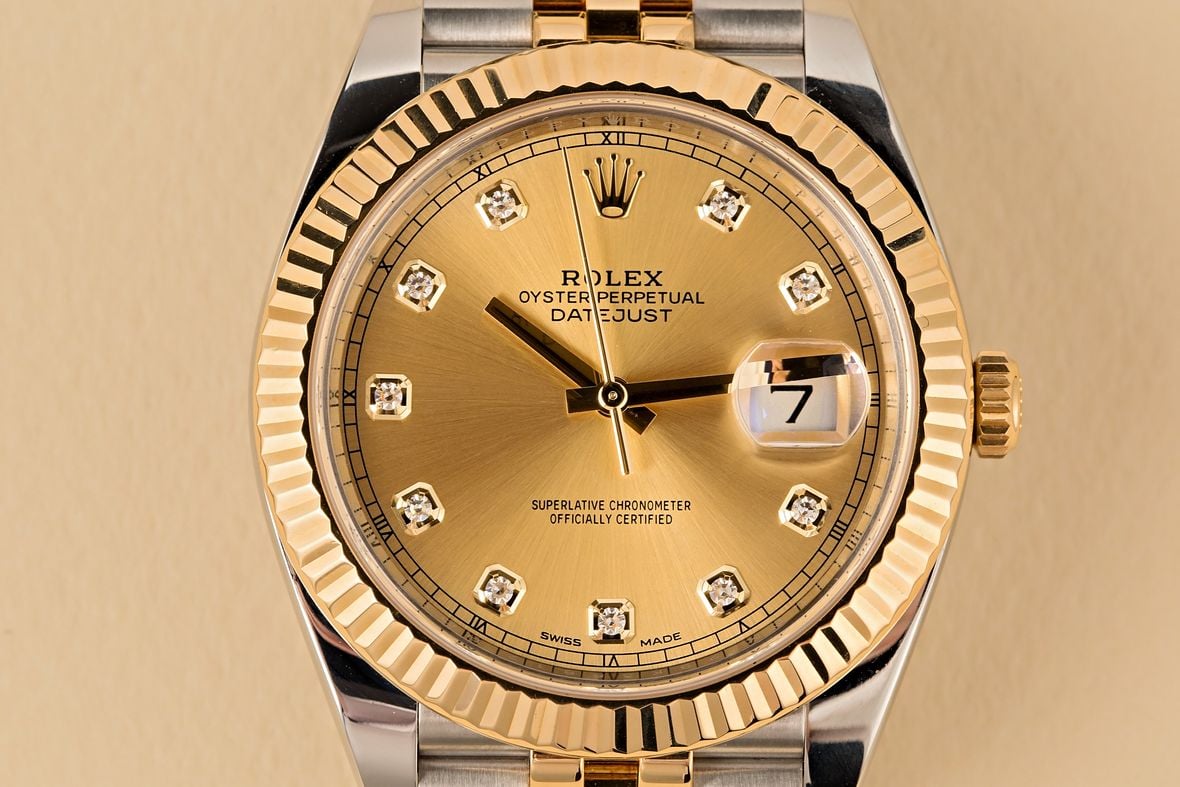
If you take a look at the Datejust section of a Rolex catalog, you will see there are an incredible number of different dials that have been made available (at least for the more long-serving members of the family). With the ref. 126333 being with us for only five years, it has amassed only six different dials, but there is more variety among them than you might think, and we have outlined the various options below.
Champagne: Without question the archetypal dial to pair with a Yellow Rolesor Datejust, and especially one with a fluted bezel and Jubilee bracelet is the Rolex 126333 champagne dial (we’ll get onto bracelets in a minute). The color matches the other golden parts of the watch perfectly, but any hint of bling is tempered by the steel elements on the case and bracelet. Traditionally available with classic stick-style hour markers, the champagne dial can also be had with diamond-set indexes.
Black: A Rolex 126333 black dial completely changes the nature of the ref. 126333. Rather than tone it down, the distinct contrast between it and the other dial components actually makes the watch pop. In addition to the champagne dial option, the black dial is the only other color with the choice of either stick batons or diamond hour markers.
White: Probably the most understated option in the collection, there is a pleasing subtlety to the Rolex 126333 white dial, and it gives a bright, summery feel to the watch as a whole. Unlike its champagne and black siblings, the white dial option for the ref. 126333 is only available with classic luminous-filled, stick-style hour markers.
Silver: The Rolex 126333 silver dials are given a sunray finish, a delicate brushing technique that radiates out from the center and causes the face to change appearance in varying lighting conditions. On the ref. 126333, the brushed pattern of the dial complements the satin finish across the outer links of the watch’s bracelet, and just like the white dial option, the silver dial is only available with the classic stick-style baton markers.
Slate: Better known as the ‘Wimbledon’ dial, this option debuted on the Datejust II in 2009, and it is another with a sunray finish. Rolex has been the official timekeeper of the Wimbledon Tennis Championships since 1978, and the colors featured here are a perfect reflection of the event’s trademark palette. The black Roman numeral indexes are outlined in a signature ‘Wimbledon Green’ and set against a slate grey background. Although some decry the lack of luminescence (only the single baton at nine o’clock receives any Chromalight), the Rolex 126333 slate dial is an exceptional and highly popular dial.
Mother-of-Pearl: Rolex has been using mother-of-pearl in its dial making since the 1970s. Not actually a pearl at all, it is taken from the interior lining of a mollusk shell, an iridescent material that is both naturally occurring and unique. Because of its natural composition, no two mother-of-pearl dials are alike, giving these pieces an inherent exclusivity. As the mother-of-pearl dials are the most expensive option available for the ref. 126333, they are only available with diamond indexes.
It is important to remember that all of these dials can be had with either the 3-link Oyster or the 5-link Jubilee bracelet, with each combination opening up a unique visual and portraying a different personality for the wearer. This is one of the reasons why the Rolex Datejust has been the spectacular success it has been for so many years – the watch itself acts as a blank canvas, with all the individuality coming from the choices made by the buyer.
Datejust 126333 Bracelet
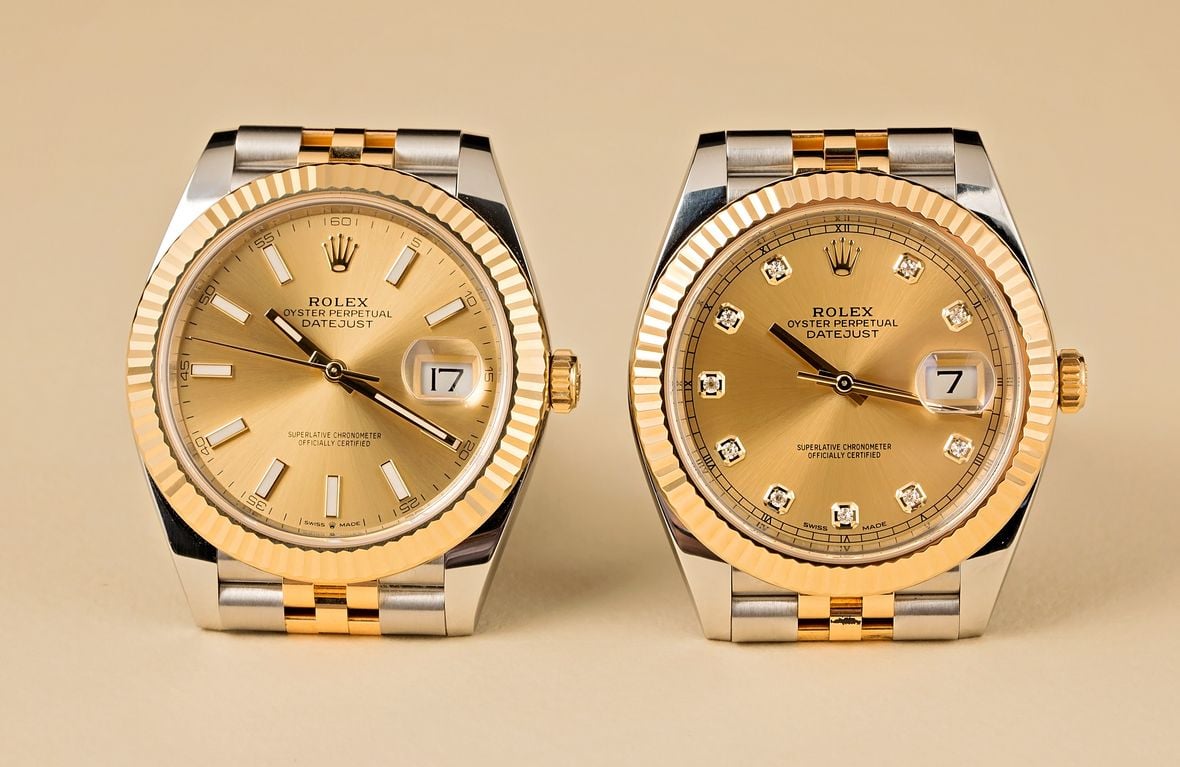
The arrival of the Datejust 41 reintroduced a bracelet style that had been conspicuous by its absence from the Datejust II when it remained in production. That model had been offered solely on the three-link Oyster, the least formal of Rolex’s main trio of metal bracelets, further reinforcing the watch’s more laidback and sporty nature.
The Datejust 41 ref. 126333 is still available on the Oyster, the steel outer links brushed and contrasting beautifully against the lustrous polish of the yellow gold center links. However, the range also comes fitted with the Jubilee – the bracelet created specifically for the very first Datejust in 1945. Its five staggered links mean that it is not only the most intricate band, but it also gives the bracelet a buttery smoothness on the wrist, making it an extremely comfortable all-day wear.
As with the Oyster bracelet, there is a combination of brushed steel and polished gold, and both bracelets come with Rolex’s patented Oysterclasp with the Easylink extension system, allowing wearers to increase (or decrease) the length of the bracelet by 5mm, completely on-the-fly and without the use of any tools.
Datejust 126333 Movement
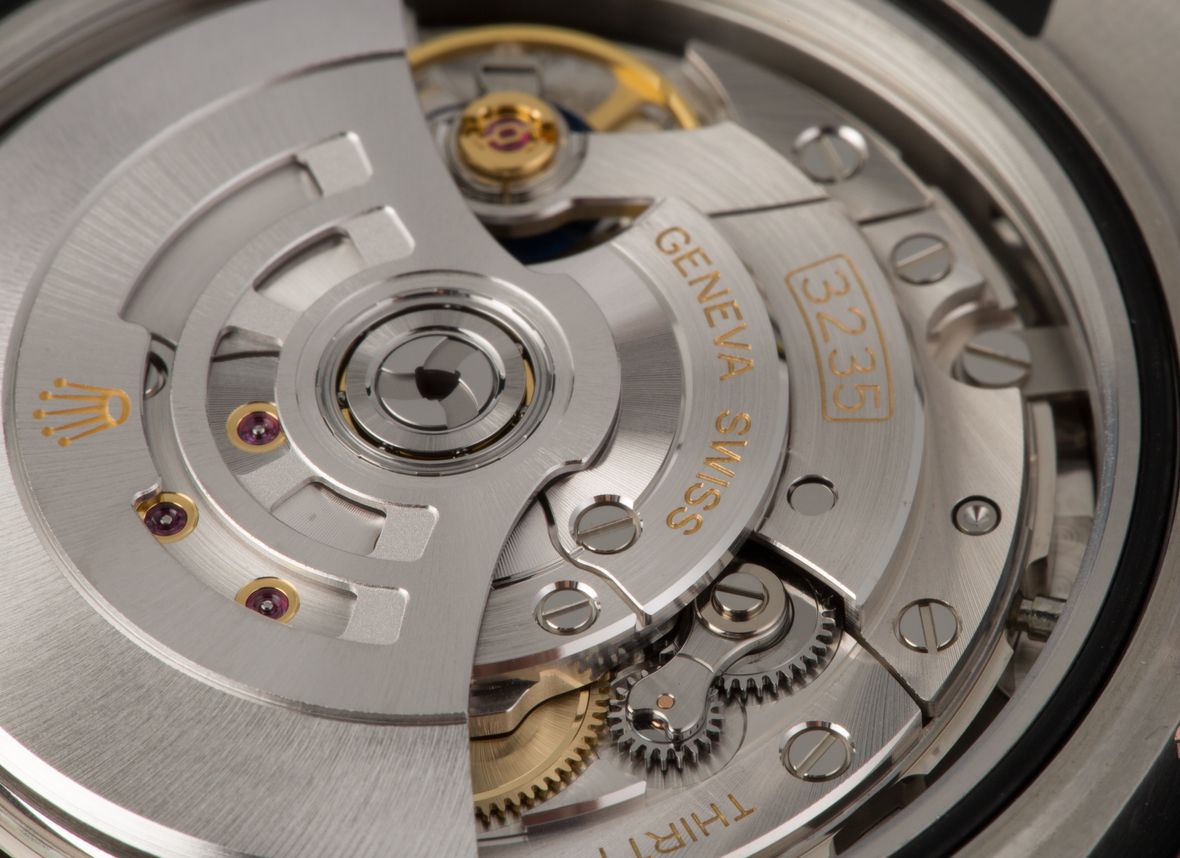
When it first debuted more than three-quarters of a century ago, the Rolex Datejust was the first waterproof, self-winding wristwatch to display the date of the month through a window in its dial. Although a revolution upon its release, the complication now seems like an extremely modest one – and yet the movement controlling it all still sits right at the cutting edge of what is achievable in mechanical watchmaking.
The Caliber 3235 is the replacement for the legendary Cal. 3135, a movement recognized as one of the finest mass-produced mechanisms ever made, and one that has served in countless Rolex watches since it was launched in 1988. When the Cal. 3235 came along in 2015, first in the then-new Pearlmaster 39, it arrived with some 90% of the components of the Cal. 3135 either upgraded or replaced entirely.
Among the improvements is a mainspring barrel with walls half the thickness of those on the outgoing caliber, which is able to house a longer, high-capacity mainspring that has upped the Datejust 41’s power reserve to 70-hours (over the previous 48 hours offered by its predecessor). Alongside that is a new monobloc rotor for the self-winding module, which now rotates on ball bearings for enhanced efficiency.
But most importantly, the Cal. 3235 has Rolex’s innovative Chronergy escapement. The part of a watch that helps control the power being delivered from the mainspring, the escapement is made up of a pallet fork and escape wheel. The two work together to release the spring’s energy in perfectly regulated increments, one tick at a time. It is a system that has been in use, in one form or another, since about 1755, and the Chronergy escapement is Rolex’s next step in its development.
Here the escape wheel has been skeletonized, reducing both its weight and, by extension, its inertia. Additionally, the teeth on the pallet fork are extremely thin but, by geometrically offsetting the piece next to its counterpart, their contact surfaces have doubled. All told the Chronergy escapement offers an increase in efficiency of approximately 15%, and by constructing it from a nickel-phosphorus alloy, it is also highly resistant to magnetic fields.
As with all Rolex perpetual movements these days, the Caliber 3235 is a Superlative Chronometer, certified by the brand itself to have an accuracy rating of -2/+2 seconds a day (after casing). Furthermore, each one comes with a 5-year guarantee and a recommended service schedule of an industry-leading 10-years.

Datejust 126333 Price
The starting price for a Rolex Datejust 41 ref. 126333 is currently $12,600. That will get you an example on an Oyster bracelet and fitted with a dial that does not have any diamond hour markers. Prices increase from there with the Jubilee bracelet equivalent retailing for $13,250, and the top-of-the-line model (featuring a Jubilee bracelet paired with a mother-of-pearl dial and diamond indexes) coming in at $18,050. All things considered, for a watch with so much history, and from a brand acknowledged as one of the most renowned manufacturers of all time, these prices are still fairly realistic (at least for now).
Usually, this would be the point where we go on to tell you about the impossibility of obtaining one through a retailer, with multi-year waiting lists present around the globe. However, that applies mainly to the stainless steel models from the Professional Collection, the iconic sport and tool watches that remain forever elusive without either a great friendship with your authorized retailer or the endless patience to sit on their waiting lists.
However, the Rolex Datejust has always been different. Considered to be the ultimate everyman watch, as in there is virtually guaranteed to be a model out there to appeal to everyone, these are the pieces that you actually have a decent chance of being able to walk into a store and buy at a retail level.
Of course, there is the flipside to that. Relatively speaking, the Datejust doesn’t enjoy the same immediate appreciation as a brand new Pepsi GMT-Master II or stainless steel Daytona. The Datejust’s availability means that it is unlikely to increase in value to the same extent as some of its siblings in the Rolex catalog. However, it is also doubtful that you will lose any money buying one either.
That being said, examples are currently trading for slightly higher than their original retail prices on the pre-owned market. Some of this may be down to the lost production time in 2020 due to COVID restrictions, but it may just be a glimpse at the future of Rolex watches, where an increasing number of them are becoming entirely unavailable at a retail level.
Conclusion
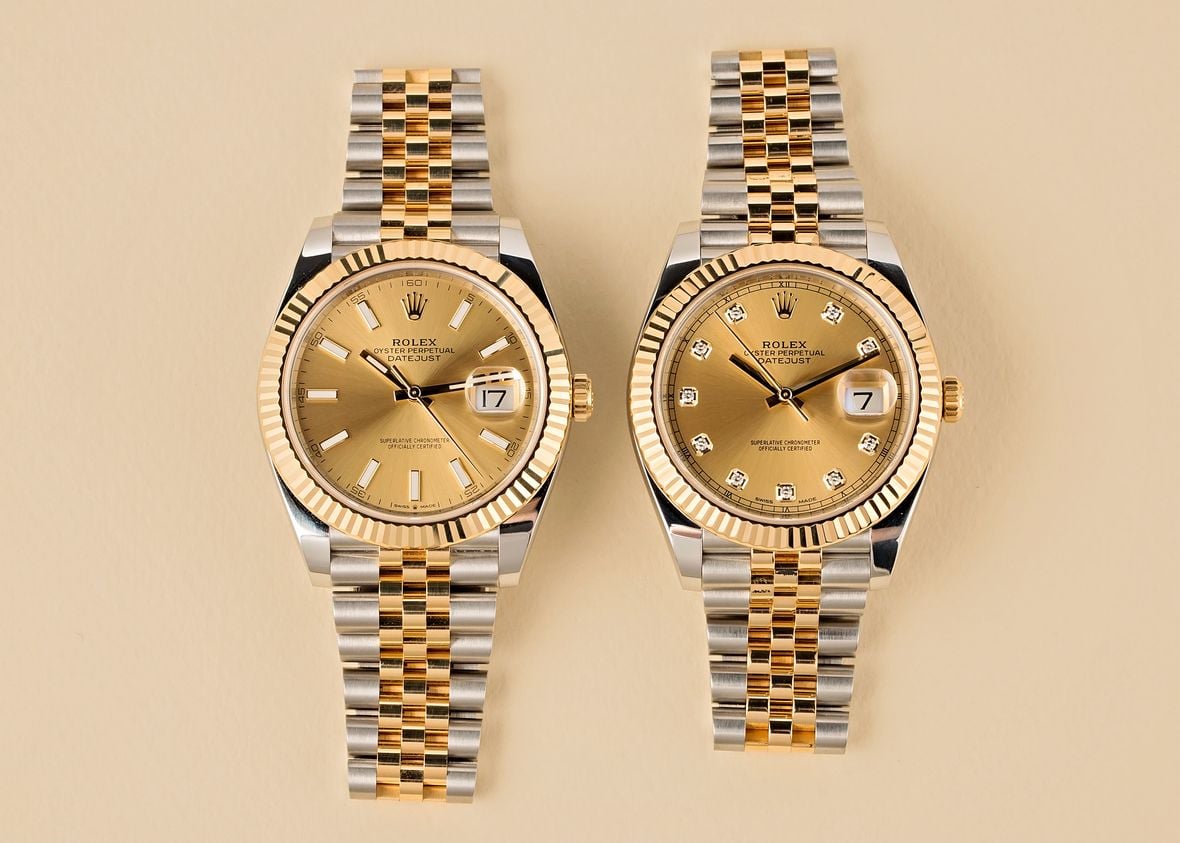
In the end, as with almost any Rolex timepiece, the Datejust 41 reference 126333 could easily be the only watch you’ll ever need. It represents the perfect modern interpretation of the quintessential luxury watch, effortlessly complementing any occasion with its sophisticated aesthetic while providing Rolex’s legendary reliability. If you’re searching for a timepiece that stands out in both style and functionality, a Rolex 126333 for sale is hard to beat, with its classic two-tone design setting a high bar that few watches can match.
